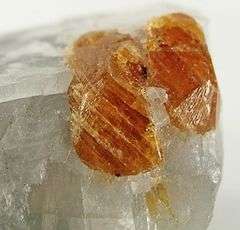Norbergite
| Norbergite | |
|---|---|
|
Norbergite crystals on calcite from Oakssaung Hill, Mogok, Mandalay, Burma (size: 4.2 x 3.3 x 2.3 cm) | |
| General | |
| Category | Nesosilicates |
| Formula (repeating unit) | Mg3(SiO4)(F,OH)2 |
| Strunz classification | 9.AF.40 |
| Crystal system | Orthorhombic |
| Crystal class |
Dipyramidal (mmm) H-M symbol: (2/m 2/m 2/m) |
| Space group | Pnma |
| Unit cell |
a = 8.747(6), b = 4.710(4) c = 10.271(8) [Å]; Z = 4 |
| Identification | |
| Formula mass | 202.00 g/mol |
| Color | Tan, yellow, yellow-orange, orange-brown, pink with purplish tint, white |
| Crystal habit | Granular, tabular crystals rare |
| Fracture | Uneven to subconchoidal |
| Tenacity | Brittle |
| Mohs scale hardness | 6-6.5 |
| Luster | Vitreous to resinous |
| Streak | White |
| Diaphaneity | Transparent to translucent |
| Specific gravity | 3.177 |
| Optical properties | Biaxial (+) |
| Refractive index | nα = 1.563 nβ = 1.567 nγ = 1.590 |
| Birefringence | δ = 0.027 |
| Pleochroism | Pleochroism: X = pale yellow; Y = very pale yellow; Z = colorless |
| 2V angle | 44 - 50° |
| Other characteristics | May fluoresce canary-yellow under SW UV |
| References | [1][2][3] |
Norbergite is a nesosilicate mineral with formula Mg3(SiO4)(F,OH)2. It is a member of the humite group.
It was first described in 1926 for an occurrence in the Östanmoss iron mine in Norberg, Västmanland, Sweden, for which it is named.[1][2][4] It occurs in contact metamorphic zones in carbonate rocks intruded by plutonic rocks or pegmatites supplying the fluorine. Associated minerals include dolomite, calcite, tremolite, grossular, wollastonite, forsterite, monticellite, cuspidine, fluoborite, ludwigite, fluorite and phlogopite.[3]
References
- 1 2 Norbergite data on Webmineral
- 1 2 Norbergite on Mindat.org
- 1 2 Norbergite in the Handbook of Mineralogy
- ↑ "Norbergite". merriam-webster.com. Merriam-Webster. Retrieved 15 September 2013.
This article is issued from Wikipedia - version of the 11/18/2016. The text is available under the Creative Commons Attribution/Share Alike but additional terms may apply for the media files.
